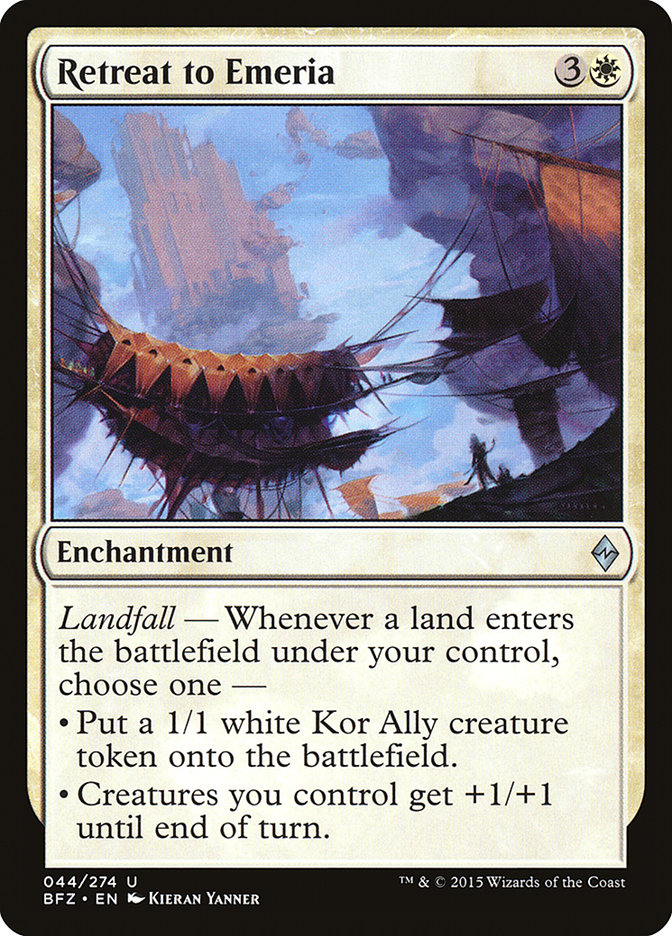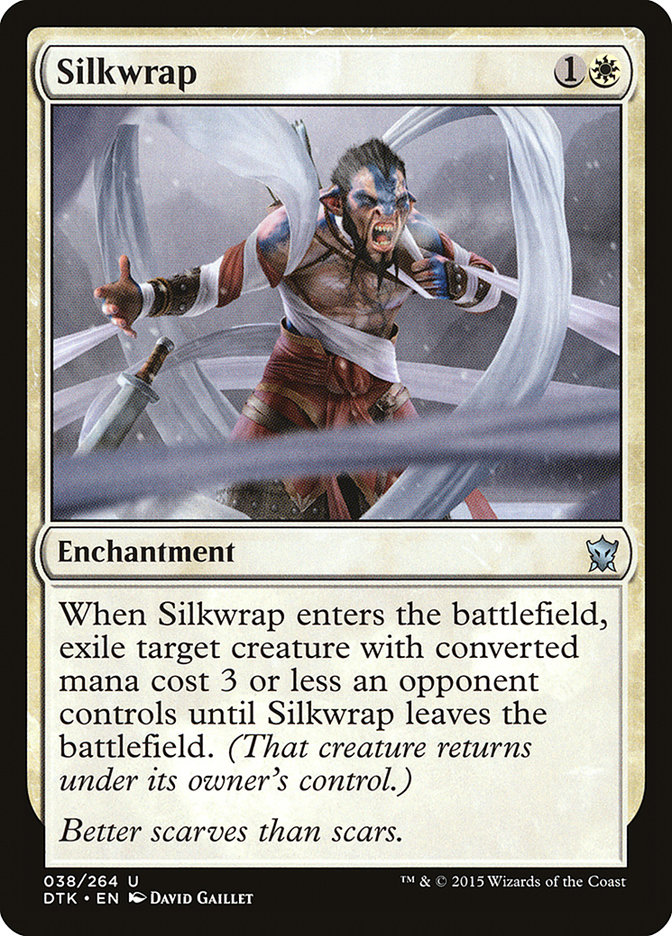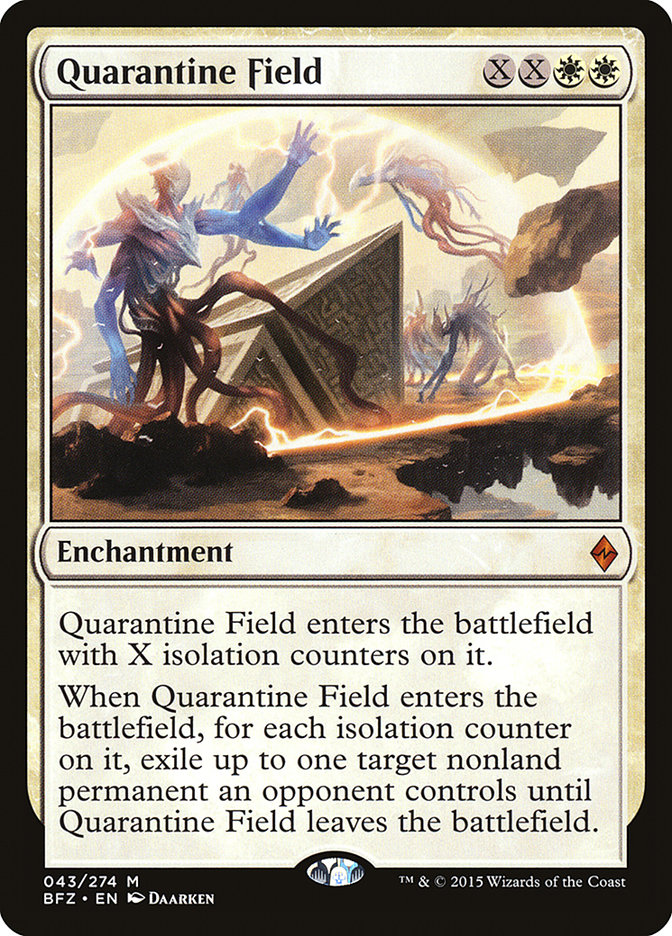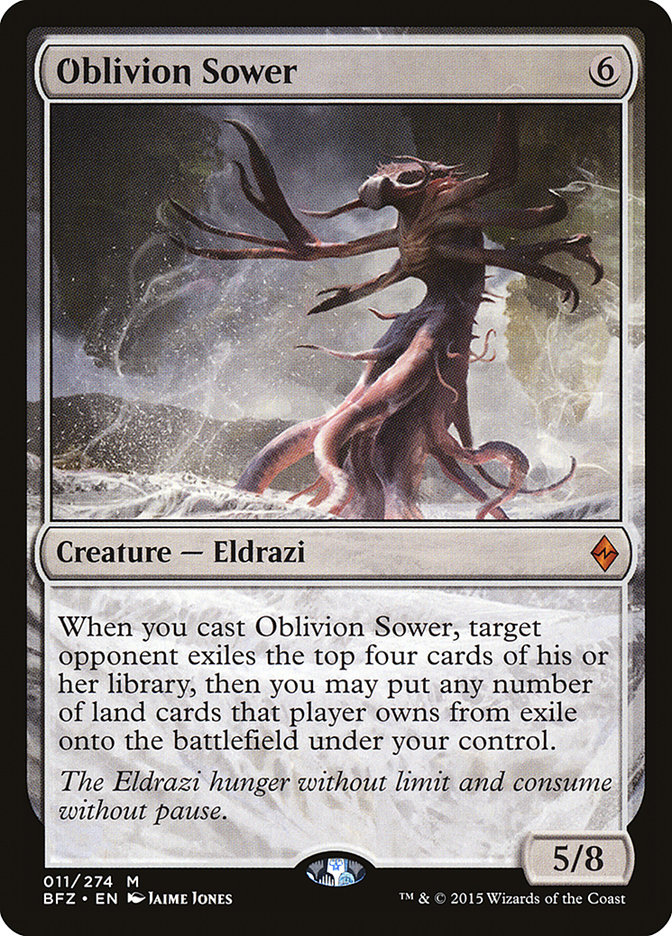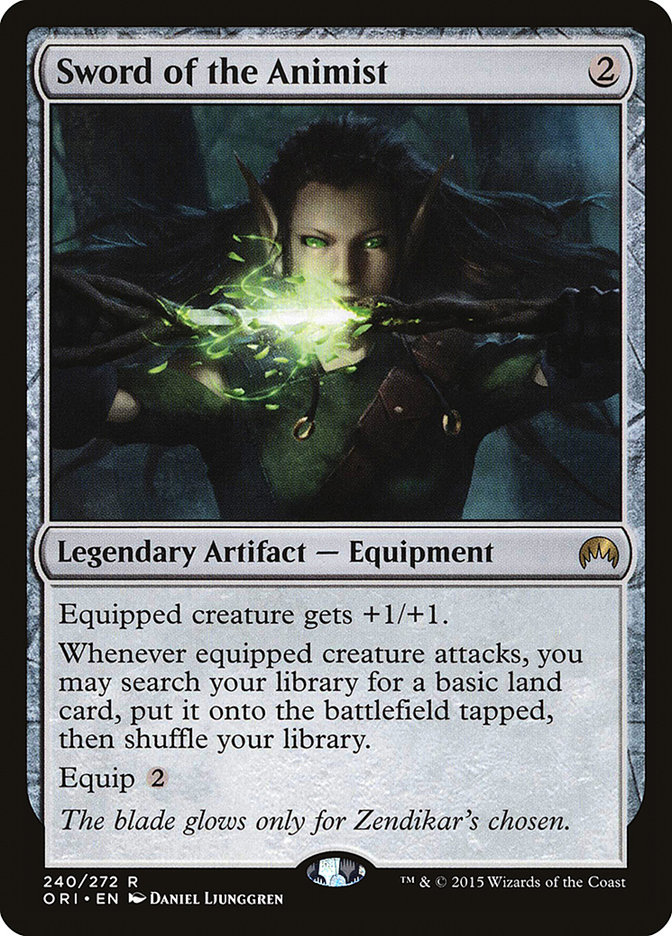“Sam, do you have good sideboard plans for this deck?”
“No, of course not, I just built it.”
–Excerpt from conversations with my team the day before the Pro Tour when trying to tell them to play my deck. Shockingly, only three others decided to
get on board.
I think I approach testing for Pro Tours differently than most, largely because I expect to try to build my own deck. Most players I know like to try
several things early on, and then prefer to “lock in a deck” maybe a week before the event–they’ll choose their archetype and then spend the last week
tuning that to the best of their ability.
For me, I tend to think of the testing period as a time to learn about as many cards and interactions as possible, to see what elements I like and what
works broadly, then as I run out of time to gather new data, I enter the synthesis phase, which I apply everything I know to building a new deck. My
teammates always complain that we could have tuned things better if we’d come up with this a few days earlier, but a few days earlier I didn’t have all the
pieces, and the thing I come up with at the end tends to be better than what I built with less information.
Of course, this doesn’t always work. Sometimes, I can’t find anything wonderful and novel, and we play something safe that we’ve tested and know is good.
Having a team that I trust is important to me because it gives me the freedom to spend my time exploring fringe strategies, knowing that if I fail, someone
else will have a tuned list of a good deck that I can play. For this event, I think Patrick Chapin had a great Esper list
(finding Duress as a great maindeck card might have been the most valuable piece that others missed), but I didn’t want to play it because I knew I’d be
too likely to pick up draws.
So that’s what was going on in a big picture sense, but as for how I came to the actual deck I played, let me explain the pieces that were synthesized.
Early on in testing, I was working on something, I’m not sure what, and Patrick Chapin asked if I’d tried Retreat to Emeria. Like most people, this hadn’t
really been on my radar as a playable card, so I hadn’t. It didn’t sound great in whatever deck he suggested it for anyway, but I tabled the idea that it
might be good.
The first deck that I worked on extensively was a W/U/B/R Control deck that I don’t call “Jeskai Black” because I didn’t play Mantis Rider, which I think
is the defining card of Jeskai that makes it make sense to think of the decks that way. Instead, this deck was based around making Ojutai’s Command as good
as possible with four Jace, Vyrn’s Prodigy, two Soulfire Grand Master, two Fathom Feeder, and a Dragonmaster Outcast as its only creatures. I liked the
deck a lot, but despite adding multiple Utter Ends and Negates, I was losing too much to Gideon, Ally of Zendikar and Ob Nixilis Reignited. Those two
struck me as two of the most important cards in the format.
I tried building a Jund Midrange deck with Ob Nixilis, but discovered that it’s very hard to gain life in this format without white, and Ob Nixilis isn’t
good if you can’t gain life. After this deck, I decided to abandon the idea of a non-white midrange deck. Aside from the fact that white had all the good
ways to gain life, which I think is important, it also had the best ways to exile, which is huge in this format between Den Protector, Ojutai’s Command,
Hangarback Walker, and Deathmist Raptor. Silkwrap quickly emerged as the best removal spell in the format, and I basically stopped considering decks that
didn’t have white.
My general approach is to try to accomplish everything I need to in the fewest possible number of colors, so I decided to look at two-color white decks. I
started with B/W since I’d been impressed by Ob Nixilis and Duress in Patrick’s Esper decks. My list was something like this:
Creatures (8)
Planeswalkers (8)
Lands (26)
Spells (18)

I think this deck is pretty good, and it was one of my frontrunners for a long time. I wouldn’t be embarrassed to play something like this in a tournament.
The first Retreat to Emeria deck I played was a U/W Control deck that I imagined as trying not to tap out until the turn it won, which it would do with a
huge overrun:
Lands (27)
Spells (33)

The idea was that I’d try to avoid breaking my fetchlands and I’d power up Mage-Ring Network, then I’d cast secure the Wastes for 3-5, untap, play Retreat
to Emeria, and break several fetchlands to kill my opponent. In practice, I generally found myself wanting to play Retreat to Emeria on turn 4-5 because it
would be enough to power through whatever my opponent played while I was tapped out. I also found myself regularly digging for two fetchlands at any stage
of the game.
Retreat to Emeria was outstanding in this deck, but the rest of the deck wasn’t that great. Well, all the white cards were good, but trying to counter
everything didn’t feel like the right approach, and at the same time, Patrick’s Esper deck was slowly moving away from counterspells.
At this point, I went back to the B/W deck and tried adding Retreat to Emeria, and I also tried building a G/W Megamorph deck with Retreat to Emeria and
Tajuru Warcaller, since it seemed like, in theory, Retreat to Emeria should be better with more creatures.
With both of these decks, I found that if I drew perfectly, Retreat to Emeria was great, but too often I wouldn’t have more lands to play, and I came to
realize that it was good in my U/W deck because I had lots of lands and card draw, so I’d never miss a land drop, but normal midrange decks couldn’t
support it well.
This is what ultimately led to the breakthrough that made me try G/W.
I woke up early, for me, on Thursday before the Pro Tour and decided I shouldn’t go back to sleep because it was better to try to get on the right schedule
for the tournament the next day. Instead, I realized that if I played creatures like Elvish Visionary and Nissa, Vastwood Seer, I could have a board full
of creatures when I played Retreat, and I’d almost never miss a land drop.
My first list included a very warped manabase to try to support a couple copies of Nissa’s Pilgrimage, which would let me play Retreat to Emeria, then a
land turn turn 4, and help keep my hand full of lands, but in practice, even playing as many Forests as possible, I just found myself running out of lands
to find. I cut those and realized I was just a white deck that splashed green for Nissa, Vastwood Seer and Elvish Visionary, which looks a little odd, but
it played out really well. I went 5-0 in a league with the version that had Nissa’s Pilgrimage before I bothered to tell anyone about the deck, because I
figured there was no reason to distract people with a last minute brew if I didn’t think it was good enough. After playing that and knowing how much I
could improve it, I was almost sure I’d play it in the Pro Tour.
We spent Thursday testing the deck and considering other cards we could play when we had one last chance–our team had a big Limited meeting scheduled in
the afternoon, and we had to go to registration in the evening.
Thursday evening, Justin read through card lists to brainstorm ideas while I drove to dinner. He suggested Quarantine Field, which I’d forgotten could
exile any non-creature, and after relearning that it could answer planeswalkers, it sounded great, and he suggested Oblivion Sower, the card most people
ask about, for the sideboard. The idea was just to have something to go a little bigger against midrange decks that would also be awesome against control
decks after they play Dig Through Time. It didn’t sound great, but I figured there was a chance it would be, and we didn’t have time to test it at this
point, so I figured giving it one sideboard slot couldn’t really hurt too much–worst case scenario, we just wouldn’t sideboard it in. It never really
mattered for me, but Ben Stark won a game with it in dramatic fashion where no other card in the history of Magic could have won the game.
One other card we brainstormed was Sword of the Animist, which sounded pretty awesome in theory–you have plenty of meaningless creatures that can hold it,
and getting extra lands onto the battlefield is always great, especially with Retreat to Emeria. I was worried that it might be too slow and clunky. I
decided that we were already taking a big enough risk playing a deck we hadn’t tested much, and that playing a card that I could imagine being really bad
in the maindeck just wasn’t a worthwhile risk. I think it’s worth testing, but as far as slow cards that provide incremental advantage, it’s hard for me to
imagine it outperforming Evolutionary Leap.
Friday morning I woke up and read Tom Ross’s article about tuning Bant Megamorph and his suggestion to play two
Lumbering Falls made a lot of sense to me. I liked the idea of getting some creature-lands in the deck anyway, and that seemed like it would offer that
access in the lategame without disrupting the general smoothness that I’d come to appreciate in this deck. Dispel also sounded pretty good, so I made that
swap at the last minute. Dispel won several games for us throughout the event, but one of the cards we most wanted more of was Blighted Woodland, and, as
an extra nonbasic land, it makes draws a lot more clunky with the blue splash, so I think either direction could be better.
All four of us–Ben Stark, Justin Cohen, Tom Martell, and I–played exactly this list:
Creatures (14)
Planeswalkers (4)
Lands (25)
Spells (17)
- 2 Dispel
- 4 Silkwrap
- 3 Secure the Wastes
- 1 Planar Outburst
- 2 Stasis Snare
- 1 Quarantine Field
- 4 Retreat to Emeria
Sideboard

Since the event, people have constantly been asking me for changes and updates and whether I’d tried various cards. No, I probably didn’t try whatever card
you wonder if I tried–I tested this deck very little; however, in my testing, I did play with a lot of different cards to understand how they play in the
format, and in decks like this, so I kind of tried them–for example, Craig Wescoe spent most of his preparation working on G/W Megamorph, and at first,
his innovation was to add Rattleclaw Mystic so that he could play the first Gideon on the draw in the mirror, because we found that having Gideon on the
battlefield first was very important when both players had Gideon. However, we found that Rattleclaw Mystic hurt his Jeskai matchup a lot, since it gave
them something to profitably kill with Wild Slash or Fiery Impulse. So I didn’t try Rattleclaw Mystic in my deck even though it seems like it would be good
for casting my four-drops because I knew that I wanted to try to make removal bad against me because I wanted to beat Jeskai.
Knight of the White Orchid is similar. It would generally be pretty good on the draw, but on the play, I wouldn’t want to wait enough to get value out of
it, because I’m good enough at hitting land drops anyway; it’s just too much, and casting a 2/2 first striker that doesn’t do anything else for me is just
too bad. We did consider putting it in the sideboard to bring in any time we were on the draw, but I don’t think you can do that with Lumbering Falls in
the deck.
Den Protector is great, and we sideboarded it in most of the time. After the tournament, Ben Stark said he would have liked to have it in the maindeck, but
I still think this is wrong. It’s the kind of card that plays better after sideboarding than before sideboarding against everyone regardless of how you’re
changing your deck, and in game 1, you’re just not putting enough cards in the graveyard.
I liked every card in the deck, so I’m not sure what I’d change yet. I was extremely impressed by Evolutionary Leap whenever I sided it in, but I’m still
not sure what I’d want to cut for it and whether I’d want it in the maindeck.
Moving forward, I’m not sure exactly how best to change the deck yet, and I’m not sure if it’s a good idea to play this deck moving forward.
Ben Stark said it was the most advantaged he’d felt in Standard since playing Caw-Blade in Paris, and my experience was similar. It’s basically the most
consistent deck in the format, all the cards are great (seriously, the list is just the list of all the cards that impressed me most in testing), and they
all work together fantastically. It has good plays at all stages of the game, and all of its draw steps are always useful because it can make such good use
of extra lands.
That said, I don’t know if it’s the best deck in Standard. I’m essentially a rogue deckbuilder–I build decks to do things people aren’t prepared for to
take advantage of people’s expectations at Pro Tours, and I don’t know how much worse this deck will be when people expect and prepare for it. I built the
deck expecting that Retreat to Emeria would be harder to take off the board than Gideon, Ally of Zendikar, something like the comparison between Outpost
Siege and Chandra, Pyromaster. If people have a lot enchantment removal, Retreat to Emeria becomes easier to answer and loses a lot of stock. Playing
against unexpected Virulent Plagues and Felidar Cub with Ojutai’s Command can be disastrous. Note, however, that I said unexpected. If you know they’re
coming, the deck can sideboard to minimize tokens or enchantments, and instead focus on planeswalkers and Wingmate Roc, so there’s a real chance that the
core of the deck is strong enough to withstand hate as long as you can find the right ways to maneuver.
If you’re looking to make changes, I’d say the last cards you should cut are Hangarback Walker and Nissa, Vastwood Seer. I know most decks don’t play four
Nissas, and it’s easy to look to that to shave a card, but seriously, don’t; it’s the best card in the deck. I could see trimming Gideon or Retreat to
Emeria–they have different strengths and weaknesses, and it’s a lot of four-mana spells. I could imagine changing the numbers on almost any other card,
though, as mentioned, they all played well for me as is. The top cards I’d consider adding are, roughly in order, Blighted Woodland, Evolutionary Leap,
Wingmate Roc, Elvish Visionary, and Den Protector. The sideboard is a lot more flexible. I like more Valorous Stance to beat R/G Landfall, I could see a
third Evolutionary Leap, since it was so good, and I could see more spell-based removal, in case you need to increase resistance to enchantment-based
removal. Archangel of Tithes is another great card that I had in the sideboard until I added the blue splash, which cut into my white sources.
If you’re trying to beat this deck, I’d look to Erase, Dromoka’s Command, Felidar Cub, and Virulent Plague. Control decks have all seemed horrible against
this, while I’ve struggled most against aggressive decks with Warden of the First Tree and Dromoka’s Command, and Autumn Burchett’s use of Archangel of
Tithes over Gideon, Ally of Zendikar in G/W Megamorph destroyed me in the last round of the PT.
Creatures (27)
- 3 Knight of the White Orchid
- 3 Wingmate Roc
- 1 Whisperwood Elemental
- 4 Warden of the First Tree
- 2 Hidden Dragonslayer
- 4 Den Protector
- 4 Deathmist Raptor
- 1 Nissa, Vastwood Seer
- 3 Archangel of Tithes
- 2 Hangarback Walker
Lands (25)
Spells (8)

One of the best things about G/W or Bant Tokens is the flexibility available in sideboarding. We really didn’t know how to sideboard for most of the PT. We
had so many good cards that we could really shift what we were doing a lot in each matchup, and while the core of the deck is really synergistic, I felt
like I could cut any part of it without disrupting the whole too much. Yes, the deck is built around Retreat to Emeria, but if my opponent is too fast or
if they have a good answer to it, I’ll cut it without hesitation.
At this deck’s core, it’s just playing the best cards with the best mana. Once I realized that white has the best removal, the best planeswalker, and the
best threats in the format, and green has the best card advantage, it didn’t seem like other colors were necessary for a control deck. The best advice I
can offer for sideboarding is to think of yourself as a token deck in game 1 and a control deck in game 2–once you properly configure for the matchup, you
can grind almost anyone out, and you rarely need to concern yourself with killing someone else before they take over. Similarly, if you’re sideboarding
against this deck, it may not be as helpful as you think to imagine that you’re playing against a token deck. Justin and I have played against a lot of Arc
Lightnings on Magic Online in the last couple days, and the card just isn’t good against this deck, trying to use cards on tokens just isn’t an effective
strategy.
So that’s where I’m at. I loved playing this deck, and I think it was the best deck for Pro Tour Battle for Zendikar. I look forward to seeing how things
will play out from here and whether it will go on to become the best deck in the format, but I really don’t know yet.

